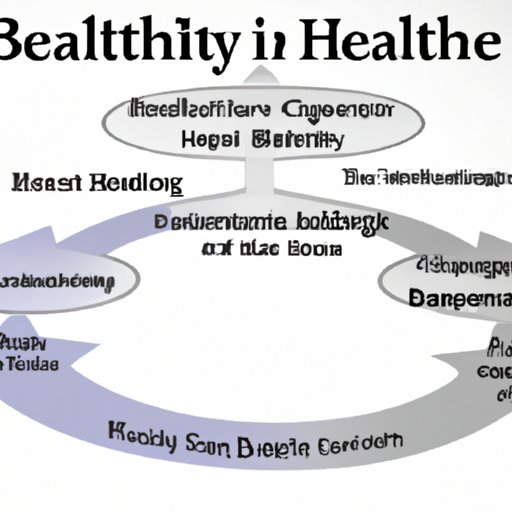Introduction: What is the Health Belief Model and How Can It Help?
The Health Belief Model (HBM) is a psychological tool used to understand and predict health behaviors. Developed in the 1950s by social psychologists at the U.S. Public Health Service, it is widely employed in public health research and practice to this day. The HBM can be used to identify and address barriers to change, motivate people to make healthy changes, and evaluate the effectiveness of programs that aim to improve health outcomes.
Comprehensive Guide to Understanding the Health Belief Model
The HBM is composed of four main components: perceived susceptibility, perceived severity, perceived benefits, and perceived barriers. Each component helps to explain why individuals engage in certain health behaviors or why they fail to do so.
Components of the Model
The first component of the HBM is perceived susceptibility, which is an individual’s perception of their risk of developing a particular health condition. This includes beliefs about how likely it is that one will contract a disease or suffer a negative health outcome.
The second component is perceived severity, which refers to an individual’s assessment of the seriousness of a particular health condition. This factor helps to explain why some people may be more motivated to take preventive action than others who view the same health condition as less serious.
The third component is perceived benefits, which is an individual’s assessment of the efficacy of taking certain actions to reduce their risk of developing a particular health condition. This component helps to explain why people may be more likely to engage in preventive behaviors if they believe those behaviors will be effective in reducing their risk.
The fourth component is perceived barriers, which refers to an individual’s assessment of the obstacles that may prevent them from engaging in certain health behaviors. This component helps to explain why people may be less likely to take preventive action if they perceive there to be significant barriers to doing so.
Explanation of Each Component
Perceived susceptibility is the individual’s understanding of the likelihood of developing a particular health condition. This component of the HBM helps to explain why people may be more likely to engage in preventive behaviors if they believe they are at risk of developing a particular health condition. For example, someone who believes they are at high risk of developing heart disease may be more likely to adopt preventive behaviors such as exercising regularly and eating a healthy diet.
Perceived severity is an individual’s assessment of the seriousness of a particular health condition. This component helps to explain why some people may be more motivated to take preventive action than others who view the same health condition as less serious. For example, someone who views heart disease as a life-threatening condition may be more likely to adopt preventive behaviors than someone who views it as a minor inconvenience.
Perceived benefits is an individual’s understanding of the efficacy of taking certain actions to reduce their risk of developing a particular health condition. This component helps to explain why people may be more likely to engage in preventive behaviors if they believe those behaviors will be effective in reducing their risk. For example, someone who believes that exercising regularly and eating a healthy diet will reduce their risk of developing heart disease may be more likely to adopt those behaviors.
Perceived barriers is an individual’s assessment of the obstacles that may prevent them from engaging in certain health behaviors. This component helps to explain why people may be less likely to take preventive action if they perceive there to be significant barriers to doing so. For example, someone who views exercising regularly and eating a healthy diet as too time consuming or difficult may be less likely to adopt those behaviors.
Benefits of the Model
The HBM provides a framework for understanding and predicting health behaviors. It can help public health practitioners identify and address barriers to change, motivate people to make healthy changes, and evaluate the effectiveness of programs that aim to improve health outcomes. According to a study published in the Journal of Health Psychology, “the HBM has been shown to be a useful tool for assessing attitudes, beliefs, and intentions related to health behaviors.”
Limitations of the Model
The HBM has several limitations. First, it does not take into account external factors such as social norms, environmental influences, and access to resources that can affect health behaviors. Second, it does not consider the complex psychological processes involved in making decisions about health behaviors. Finally, the model does not adequately explain why people engage in unhealthy behaviors despite knowing the risks.

Using the Health Belief Model to Promote Positive Health Behaviors
Public health practitioners can use the HBM to promote positive health behaviors. By understanding the components of the model, practitioners can identify and address barriers to change, motivate people to make healthy changes, and evaluate the effectiveness of programs that aim to improve health outcomes.
Identifying and Addressing Barriers to Change
By understanding the components of the HBM, public health practitioners can identify and address barriers to change. For example, if someone perceives there to be a high barrier to exercising regularly, the practitioner can provide resources and strategies to help the individual overcome that barrier. This could include providing information about free or low-cost exercise classes in the area, or helping the individual find a buddy to exercise with.
Strategies for Motivating People to Make Healthy Changes
The HBM can also be used to motivate people to make healthy changes. For example, by understanding an individual’s perceived benefits and barriers, the practitioner can tailor messages to increase the individual’s motivation to take preventive action. This could include providing information about the potential health benefits of taking preventive action, or highlighting strategies to reduce the perceived barriers to doing so.

How the Health Belief Model Can Be Applied in Public Health Practice
The HBM can be applied in public health practice in a variety of ways. For example, it can be used to design and implement interventions that target specific populations or address specific health issues. It can also be used to assess health beliefs and behaviors, and evaluate the effectiveness of public health programs.
Examples of Applications
One example of how the HBM can be applied in public health practice is in the development of interventions to prevent smoking. By understanding the components of the HBM, public health practitioners can identify and address barriers to quitting smoking, such as the cost of smoking cessation aids, or the perceived difficulty of quitting. They can also develop messages that emphasize the potential health benefits of quitting smoking and highlight strategies to reduce the perceived barriers to doing so.
The HBM can also be applied in the evaluation of public health programs. By understanding the components of the model, public health practitioners can assess whether a program is having the desired effect on health beliefs and behaviors. For example, a program designed to increase physical activity levels among children could be evaluated using the HBM to assess whether it is increasing the perceived benefits and decreasing the perceived barriers to physical activity.
Considerations for Implementing the Model
When implementing the HBM in public health practice, it is important to consider the cultural and socio-economic context in which the intervention is being implemented. Different populations may have different perceptions of health conditions, benefits, and barriers, which could influence the success of the intervention. Therefore, it is important to take into account these contextual factors when designing and implementing interventions.
Examining the Impact of the Health Belief Model on Health Outcomes
The HBM has been used in numerous public health programs and interventions, but the impact of these programs on health outcomes is still unclear. To better understand the effectiveness of programs utilizing the HBM, it is important to evaluate the impact of these programs on health beliefs and behaviors.
Evaluating the Effectiveness of Programs Utilizing the Health Belief Model
It is important to evaluate the effectiveness of public health programs that utilize the HBM. This can be done by assessing the impact of the program on health beliefs and behaviors. For example, a program designed to increase physical activity levels among children could be evaluated by assessing changes in the perceived benefits and barriers to physical activity.
Exploring Opportunities for Further Research
Although the HBM has been used in numerous public health programs and interventions, there is still much to learn about its effectiveness in promoting positive health behaviors and improving health outcomes. Further research is needed to evaluate the impact of the HBM on health beliefs and behaviors, and to explore opportunities for its application in other public health contexts.

Conclusion: Summary of the Health Belief Model and Implications for Improving Health Outcomes
The Health Belief Model is a psychological tool used to understand and predict health behaviors. It is composed of four components – perceived susceptibility, perceived severity, perceived benefits, and perceived barriers – that help to explain why individuals engage in certain health behaviors or why they fail to do so. The HBM can be used to identify and address barriers to change, motivate people to make healthy changes, and evaluate the effectiveness of programs that aim to improve health outcomes. However, further research is needed to evaluate the impact of the HBM on health beliefs and behaviors, and to explore opportunities for its application in other public health contexts.
(Note: Is this article not meeting your expectations? Do you have knowledge or insights to share? Unlock new opportunities and expand your reach by joining our authors team. Click Registration to join us and share your expertise with our readers.)
